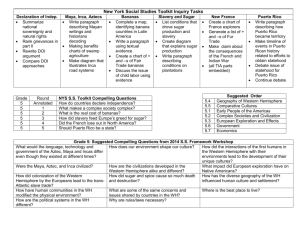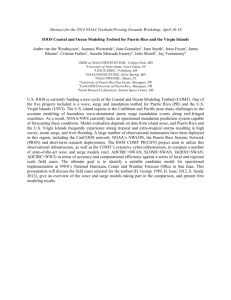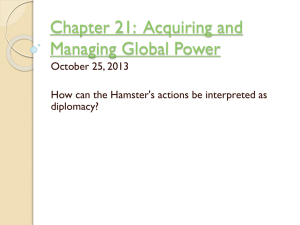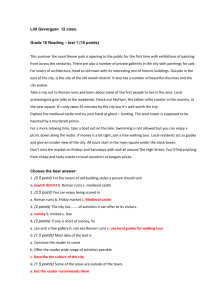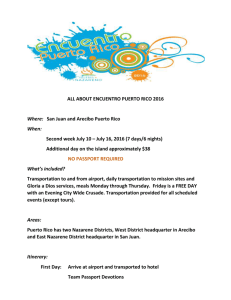Puerto Rican
advertisement
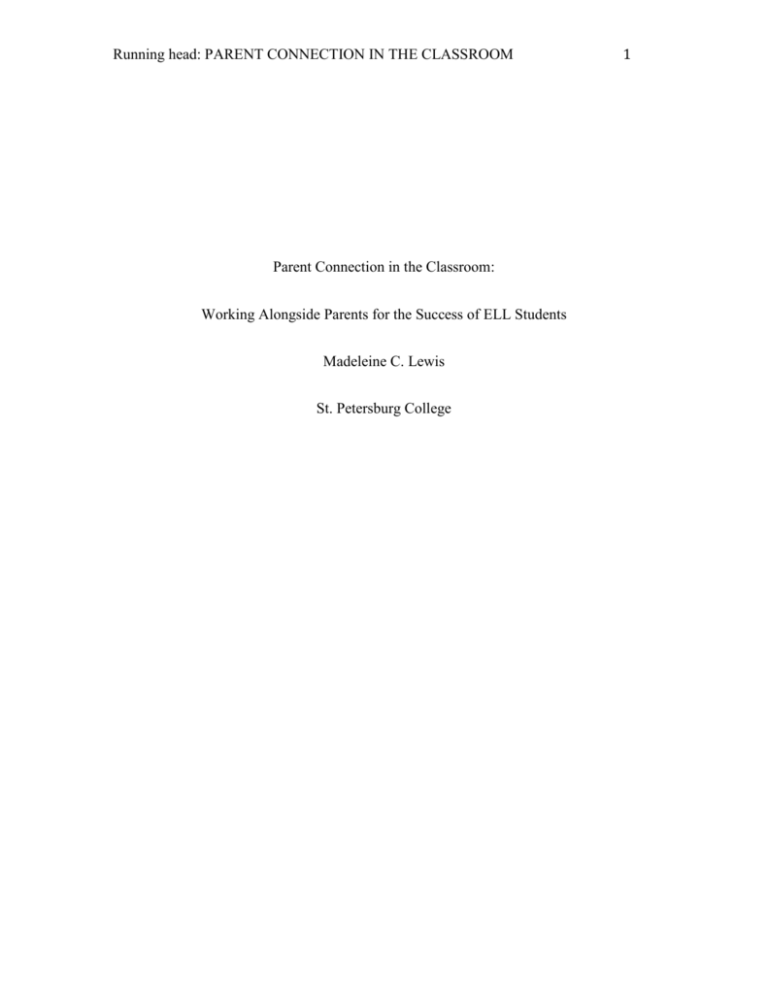
Running head: PARENT CONNECTION IN THE CLASSROOM Parent Connection in the Classroom: Working Alongside Parents for the Success of ELL Students Madeleine C. Lewis St. Petersburg College 1 PARENT CONNECTION IN THE CLASSROOM 2 “Research has shown… parent involvement leads to better attendance, higher achievement, improved attitudes about learning, and higher graduation rates… children from minority and low-income families gain the most from parent involvement” (Epstein, 1990 p. 43). For immigrant or non-English speaking parents, the lack of parent involvement is not out of hostility or disinterest in their child or the class. Factors that traditionally prevent parents from participating in school functions are that of cultural, linguistic, and situational circumstances. Families do not want to overstep their boundaries or feel incapable in their communication skills. Cultural barriers include the most basic and simple issue, a difference in culture. With aspects of respect, honor, manners, and religious actions, cultures can differ greatly and cause much confusion and disconnect between individuals and in the classroom. Parents may not be involved with their children in the class the way American parents are because in their country, it is not expected or possibly even considered rude. If their culture believes that the teacher is the power of the class, then they will not want to intrude or make waves in their child’s educational advances. Linguistic barriers include language and the obvious inabilities to speak the languages of one another. A parent who speaks only Spanish is not going to understand or feel comfortable speaking in depth about their child’s education in English, or worse, a style of broken English/Spanish. Neither party wants to feel inadequate or have their character seem less. There are also many parents of ELLs that can not read or write in English, or their native language. This creates an added linguistic barrier in that communication is further suppressed, easily leading to miscommunications. Situational barriers include all other aspects of parents not being involved. The family could not have ample transportation, the parents may not PARENT CONNECTION IN THE CLASSROOM 3 want to feel put on the spot or feel dumb. They may also not want to make the wrong impression by seeming pushing or forthright. All aspects do not suggest or imply that parents of ELLs do not want to see their child succeed. They also do not imply that parents do not want to be involved. Parents of ELLs have expressed feelings of discouragement, where in they “felt disregarded and left powerless in their attempts to be involved in the school” (Perez Carreon, Drake, & Calabrese Barton, 2005 p. 45). This can not be allowed to happen in our classrooms. Parent involvement needs to be a constant, no matter the language proficiency level. Due to the cultural, linguistic, and situational factors that prevent immigrant and non-English speaking parents from participating in school functions, I researched Puerto Rico in order to understand and present a culturally inclusive environment for said individuals. Puerto Rico is a Commonwealth territory of the United States of America. Spanish is the main language spoken in Puerto Rico, with limited English spoken proficiently by less than 1/4 of the population. Puerto Ricans have American citizenship, currency and common defense. Nearly four million people live in Puerto Rico, which makes it one of the most densely populated islands in the world. “Over 2 million Puerto Ricans live in the United States, primarily in the northeast.” (Zentella, 2005). These Puerto Rican Americans are in a state of cultural limbo, where they are American citizens, yet still considered ‘foreigners’. “In recent years, many Puerto Ricans have returned to their island home, in large part because of inadequate economic opportunity in the United States.” (Rivera, 2012). PARENT CONNECTION IN THE CLASSROOM 4 “During the first three hundred years of Spanish rule education in the Island was limited to the teaching of Christian doctrine, arts, and grammar.” (Zentella, 2005). Therefore, almost the entire population was illiterate up until the mid 1900s. “November of 1934, Commissioner José Padín ordered that instruction be given in Spanish in all elementary grades with English taught as a special subject from the first grade.” (Rivera, 2012). Since then, Puerto Rican schools are required to teach firstly in Spanish and gradually more and more English throughout every schooling year. “The language used in the schools is Spanish, however, English is taught from kindergarten to high school as part of the school curriculum and some private schools provide English programs where all classes are conducted in English.” (Rivera, 2012). “Education is a matter of high priority for Puerto Rico. This is evident in the island's overall literacy rate of 90 percent and education receiving 40 percent of Puerto Rico’s budget.” (Duany, 2002). Children are obligated to go to school from first grade, six years old, to high school graduation at seventeen or eighteen years old. The schooling years are split into primary and secondary levels, much like that of our schools in the US. “Puerto Rico has more than 50 institutions of higher education and has achieved one of the highest college education rates in the world (6th).” (Rivera, 2012). There are more students in public schools than private schools, with homeschooling rates growing quickly. With the incredible importance that is placed on education, the teacher is considered the best imparter of knowledge and is the ruler of the classroom. There is not as much involvement in the classroom between teachers and parents; it would be considered judgment on the part of the parents and make the teacher seem less than his/her professional status. PARENT CONNECTION IN THE CLASSROOM With Puerto Rico being somewhat of a melting pot, within the American melting pot, “Puerto Ricans are among the most ethnically and racially diverse people in Latin America...” Cultural practices in Puerto Rico are that of respect, with a large importance on family structure. “Puerto Rican family and community dynamics have a strong Spanish influence and still tend to reflect the intense patriarchal social organization of European Spanish culture.” (Duany, 2002). This goes with the idea of the man as the head of the household, providing for his family, while the woman stays home and raises the children. Puerto Rican families place high importance on honor, with “interactions between family members and others expected to be courteous, honorable, and considerate.” (Rivera, 2012). Some social and cultural norms include: adult children living at home until marriage, married couples living near their parent’s homes, and multiple generations living under one roof. In summation of the three articles and my findings, we as teachers need to make sure that we are constantly looking beyond ourselves. We need to be aware of other cultures and keep challenging ourselves by furthering our educational advances. In the classroom, we need to make sure we are not expecting more from our students than is developmentally and linguistically appropriate. When it comes to parents of ELLs thinking that they should stop speaking their native language, we as teachers must encourage the speaking of both. “Emphasize the importance of teachers building on students’ home language for learning” (Zentella, 2005 p. 45). We need to explain to parents that allowing a child to master their native language, makes for an easier time learning English. The transition to speaking English will be less strenuous because the rules and standards for sentence structure will already be set in place. 5 PARENT CONNECTION IN THE CLASSROOM 6 Teachers need to keep a constant and open line of communication with students and parents. “Teachers, school administrators, and interpreters can make contact and build trust by visiting the student and family at home. This initiates goodwill and welcomes the new family.” (Ariza, 2000 p. 38). Teachers may also need to thoroughly explain at the beginning of the year that a call or note will be sent home once a month on the child’s behavior or work, but that it is not necessarily a bad thing. The teacher can set up regular meetings to make sure the entire family is on the same page with schooling and expectations. First and foremost, a teacher should know the students and find out everything they can – for example, certain aspects of each child’s cultural background. The teacher can send home a letter before the start of school to get a base line of the family. This will make evident circumstances such as a parent not being able to read and write or a cultural aspect that needs further research. That way you know that some parents can only communicate on the phone or in person or that an interpreter may need to be present. This will also preemptively stop issues of major miscommunications and cultural differences. This way, a teacher will not have misinterpreted feelings when a parent of a different culture, refuses or ignores invitations to the classroom. Overall, a teacher need not make any assumptions or misinterpretations towards any student or parent. In conclusion, due to the cultural, linguistic, and situational factors that prevent immigrant and non-English speaking parents from participating in school functions, I researched Puerto Rico in order to understand and present a culturally inclusive environment for said individuals. This will be done through a potluck cultural celebration. Every family in the class will be encouraged to make and/or bring an item of food to the PARENT CONNECTION IN THE CLASSROOM 7 class that represents their culture, heritage, country of origin, or family. Parents and children will also be given the opportunity to bring an item that represents their culture or heritage and speak about it’s importance or meaning. Parents that are unable to cook or would rather not bring food may sign up to bring other essentials, such as plates and napkins. This event will be held in the classroom and in lieu of their scheduled lunch period and next scheduled activity (ie: PE). This will give enough time for everyone to eat, explore, talk with others, and allow time for those who feel like presenting or sharing. Parents and children will have the opportunity to learn from one another through foods and personal items that are culture and regionally specific. This will be a fun and entertaining event with little pressure in a somewhat unfamiliar arena. The understanding of their own culture and dish will set a sense of ease and open the floor to discussion about other cultures. This will, in turn, show our students the importance of heritage and culture. Children and parents will have a better grasp of other people and cultures, gaining more respect and understanding to something they may have not known before. PARENT CONNECTION IN THE CLASSROOM 8 References Ariza, E. N. (2000). Actions speak louder than words- or do they? Debunking the myth of apathetic immigrant parents in education. Contemporary Education, 71, 36-38. Ariza, E. N. (2002). Cultural considerations: immigrant parent involvement. Kappa Delta Pi Record, 38, 134-137. Duany, J. (2002). The puerto rican nation on the move. Chapel Hill, 424-440. Epstein, J.L. (1990). School and family connections: Theory, research, and implications for integrating sociologies of education and family. In D.G. Unger & M.B. Sussman (Eds.), Families in community settings: Interdisciplinary perspectives (pp. 99-126). New York: Haworth Press. Garcia Coll, C., Akiba, D., Palacios, N., Baily, B., Silver, R., DiMartino, D., & Chin, C. (2002). Parental involvement in children's education: lessons from three immigrant groups. Parenting, 2, 303-324. Perez Carreon, G., Drake, C., Calabrese Barton, A. (2005). The importance of presence: Immigrant parents’ school engagement experiences. American Educational Research Journal, 42 (3), 465-498. Rivera, M. (2012). History of Puerto Rico. Retrieved from http://www.topuertorico.org/. Zentella, A.C. (2005). Premises, promises, and pitfalls of language socialization research in Latino families and communities. In A.C. Zentella (Ed.), Building on strength: Lanauges and literacy in Latino families and communities (pp. 13-30). New York: Teachers College Press. PARENT CONNECTION IN THE CLASSROOM Los padres y alumnos, únete a nosotros Viernes 24 de Febrero para una celebración cultural! Nuestra clase va a tener una cena. Se llega a probar alimentos nuevos y conocer gente nueva. Usted puede traer una partida de alimentos que representa a su familia, país o cultura. Los estudiantes pueden explicar la importancia de la comida a la clase. También puede traer un elemento que es importante para su cultura, el país, el patrimonio, o de la familia. También habrá una hoja de inscripción de los elementos necesarios: de hielo, vasos, platos, cubiertos, servilletas y bebidas El potluck estará en mi salón de clases el viernes 24 de febrero 2012 a partir del 12-1pm. Será durante el almuerzo de los niños y la hora programados PE. Sé que esto no está perfectamente traducido, pero esta es mi mejor intento y lo siento por la confusión. 9



